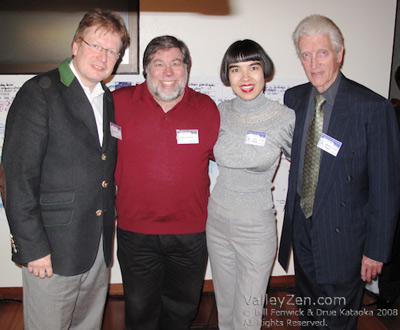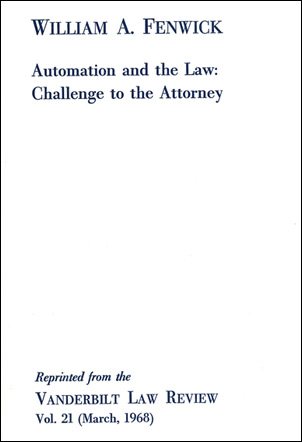Doug Engelbart’s Legendary 1968 Demo & The Birth of Collective Intelligence

Steve Wozniak & Steve Jobs – Collective Intelligence in 1976
The first time I met Apple Co-Founders Steve Jobs and Steve Wozniak was in 1976 when they came to my office to talk about a company they were starting. Back then, Wozniak and Jobs were leaders in the two strongest directions of Collective Intelligence– building tools to achieve extensions of the human being, and facilitating the collection of human thoughts in a shared repository. Indirectly, the two Steves were followers of Doug Engelbart, the leader in the field of Collective Intelligence. Doug Engelbart’s concept of the use of a mouse was implemented by Apple to revolutionize a new human machine interface.
Reunion with Woz in 2008
Fast forward to last month, when Drue and I met Woz after his talk at an event dedicated to and attended by Doug Engelbart and his wife Karen Engelbart. The Tech Museum of Innovation hosted and sponsored The Program for the Future conference (also supported by Stanford, MIT, & SRI). The conference celebrated the 40th anniversary of Engelbart’s astounding Demo which marked the public birth of Collective Intelligence. Program for the Future brought together leading minds in science, media, business and education to talk about the past, present and future of Collective Intelligence. Check out the ValleyZen Flickr Photo Set here.
Doug Engelbart’s 1968 Demo and its followers
ValleyZen is inspired by Doug Engelbart’s continuing vision of harnessing technology for human betterment. Back in 1968, Doug’s combining of the transmission of video, voice and data to create a collaborative environment populated with people in disparate locations was far more futuristic (and accurate) than Orwell’s negative Utopia depicted in his novel “1984.”
Engelbart’s original epiphany led him to conclude (1) superior solutions to important complex problems required the collective intelligence of multiple participants to define and resolve the problems, (2) the definition and resolution of the problem required simultaneous, real-time, collaboration, (3) such collaboration required special communication and other tools that lowered the thresholds of efforts necessary to participate in the collaboration (4) multiple people gathering and analyzing relevant information generated solutions superior to those generated by individual intelligence, and (5) someone would have to create appropriate collaboration tools. Those tools would minimize obstacles to real-time visual, voice and text collaboration among those persons possessing relevant intelligence for generation of superior solutions to complex problems plaguing societies.
Doug’s epiphany caused him to undertake an effort to prove technology could be the source of needed tools. He created a series of computer programs and equipment that provided a communication interface between people and computers. His proof of concept was a demonstration presented in 1968 (which widely became known as “The 1968 Demo.”) The Demo ignited, inspired and provided direction to the enormous efforts that led to personal computers, networks and the world wide web. Thus the Program for the Future was tagged as the “40 Year Celebration” to honor Doug’s extraordinary accomplishments.
In an effort to better appreciate Doug’s incredible vision, we repeatedly viewed the video of The 1968 Demo and reviewed an article I wrote in 1966 (published in 1968) entitled “Automation and the Law: Challenge to the Attorney” which attempts to describe the state of electronic information handling in 1968. [See photo below of cover of the Vandy Law Review Article].  When the Law Review Article was written there were no networks available to the public. The fastest reliable remote transmission of machine ready digital information available for non-governmental, non-scientist data processing was a tape transceiver which would receive digital data from remote punch card readers and duplicate it on magnetic tape in a format that replicated the data in the same format as a card-to-tape run on a 2nd generation computer.
When the Law Review Article was written there were no networks available to the public. The fastest reliable remote transmission of machine ready digital information available for non-governmental, non-scientist data processing was a tape transceiver which would receive digital data from remote punch card readers and duplicate it on magnetic tape in a format that replicated the data in the same format as a card-to-tape run on a 2nd generation computer.
In other note worthy occurrences at the Program:
- Peter Friess gave an excellent description of The Collective Intelligence Challenge as well as an explanation of how The Tech’s activities are directed as much to describing the future as to recording the historical.
- Steve Wozniak gave a brief introduction of V. Swaminathan after which he and Bill Fenwick had a brief re-union (Apple Computer was one of the early startups incorporated by Fenwick & West). Woz agreed to a later more detailed discussion ValleyZen (watch for a future Post);
- Professor Hiroshi Ishii shared some of the exciting projects and tools MIT Media Lab is building and working including the The Art of tangible bits.
- Nicole Baker’s with Juanita Brown’s presentation and demonstration using the World Café at Stanford University orchestrated discussion groups using the Visual Interactive Engelbart Timeline Mural prepared for use at the conference.
- The Innovating Innovation Panel discussed “How do we best realize Doug Engelbart’s vision of combining people and technology to nurture innovation and better humanity, by addressing major challenges as well as creating new industries, products and jobs? With an ever widening digital divide, how do we ensure that innovation benefits all segments of society in both developing and developed countries? How can we most prudently and fairly balance innovation risks and rewards? Who should participate in the dialogue?”
- A special awards ceremony dinner was hosted by Adobe where Creative Commons was honored with the first Collective Intelligence Recognition Award for an organization. In addition, Tim O’Reilly, founder and CEO of O’Reilly Media, Inc. received the individual Collective Intelligence Recognition Award for his efforts to promote open participation and collective intelligence on the web. As Engelbart presented the award he said: “Along the digital frontier, we rely on our scouts to explore the terrain and exchange information at the trading posts. Tim O’Reilly has set up the ‘Internet Pony Express’ to broadcast the possibilities of Open Source and Web 2.0 to the rest of the world.
ValleyZen looks forward to the Next Program for the Future’s conference.




I am glad to learn that Bill Fenwick’s firm was an early user of Apple computer. I cannot talk about open source and Mr. Engelbart, but I wonder at Steve Wozniak’s resurfacing at the moment when Steve Jobs is in personal trouble. I cannot but wish, even pray for Steve Jobs’ recovery. He had single-handedly saved Mac – an unparalleled product and the Apple company providing an unequaled service. I don’t know if open source and licensing other companies to produce Mac-clones have anything in common, but the latter practice by Amelio et co. made Apple a fast sinking ship, until Steve Jobs jumped in and took the wheel. I am amazed at speculations about Job’s health and the future of the company. May we all, who use our wonderful Powerbooks and other products, pray for his health in gratitude, but also for the sake of his well-being in his personal life.